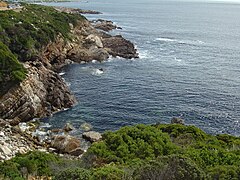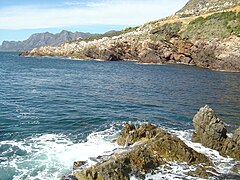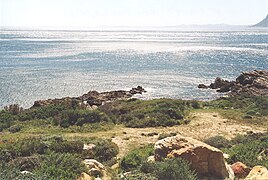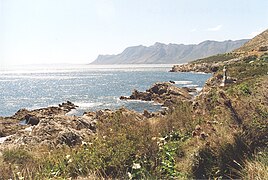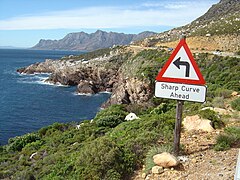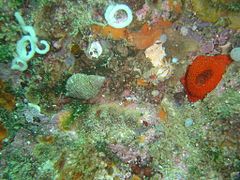The Dive site Percy's Hole is an inshore rocky reef in the Rooi-els area on the east side of False Bay, near Cape Town in the Western Cape province of South Africa.
Understand
[edit]

This is one of the best known and most interesting sites on the east side of False Bay. It is topographically varied and has a high biodiversity. The site is usually dived from the shore and the entry points are well protected, but require some effort to reach from the road.
Position
[edit]1 Percy's Hole gully: S34°17.350’ E018°49.377’ 18 km South of Gordon's Bay, on the headland just to the north of the beach at Rooi-els.
This is not in a Marine Protected Area. A permit is not required.
Name
[edit]No-one seems to know who Percy is or was, and why this site should be named "Percy’s Hole", but it has been known by this name since before 1983.
Depth
[edit]The bottom is generally from 14 m to 20 m, unless you swim way out where 23 m can be found on the sand. The subtidal shoreline is unusually steep, and depths of over 10 m are very close to the water's edge. This site is probably the place in False Bay where the 20 m contour is closest to the shore. A depth of 14 m can be found within about 30 m of one of the entry points, and within 10 m horizontal distance of the nearest shore.
Visibility
[edit]Visibility is not usually very good. 3 to 5 m is fairly common, but occasionally 10 m+ has been reported. Good visibility is sometimes associated with cold water and often with long periods of offshore wind (South easterly) and low westerly component to the swell, but is not predictable with any certainty.
Topography
[edit]General layout The entry point is in the small gully to the left of the main gully, running inshore of, and parallel to, the two ridges. There is a stepped wall on the outside of the outer ridge, which is a good site for a night dive.
The gully drops down to 14 m depth between the heads. There is a stepped wall (2 levels) with an overhang at the bottom to the south, and extensive rocky reefs to the north, with a swim-through inshore of the exposed rock pinnacles (Seal Rocks). To seaward of seal rock there are high reefs, and to the north of these the bottom slopes down to a sand bottom at 23 m.
North east side of entry gully, sharp right: The mouth of the gully drops to 14 m. There are some big boulders lying on the bottom and a tall narrow outcrop with kelp on top. The shoreline wall to the north has quite a deep overhang and runs approximately east magnetic until it forms a strait between Seal Rock reef and the shore. It gets shallower until a huge boulder almost blocks the gully, close to where the bigger Seal Rock breaks the surface. Under this is the tunnel (swim-through) in a deep part of the gully. It has a nearly level bottom covered with small water-rounded boulders, and vertical access at the south end and in the middle. The north end access is stepped down into the tunnel by about a metre.
Beyond the tunnel the strait widens and is partly blocked by some large outcrops and boulders. The Seal Rock reef continues parallel to the shoreline for some way then tapers down. Beyond this, to seaward, the bottom flattens out and becomes a gently sloping pebble/gravel bed, ending at sand, This reef comprises large sandstone outcrops, and has deep overhangs along part of its length at the bottom of the north-eastern face. One overhang extends about two metres under the rock with a maximum height of about a metre, and is several metres long.
Far north-east: The shoreline of the north east of the north cove includes a small cave at the end of one of the deep gullies that indent the shoreline in this area. The gully bottom is at about 9 m, with small to medium rounded boulders on the bottom, then steps up vertically to about 5 m depth at the mouth of the cave.
The cave is about 7 m wide at the mouth, and the roof is arched and extends to slightly above sea level at most tides. The cave is straight and approximately semi-elliptical in plan, extending roughly 20 m into the rock in line with the gully. The floor slopes gently up and the roof down to the back. There are a few large boulders and a lot of small ones on the floor, but the entrance is at all times at least partly visible from the back and would be classed as a cavern for diving. There is a fairly deep horizontal crevice at the base of the north side which is sometimes occupied by large numbers of White seacatfish.
Straight out from gully, and a bit to the right: From the gully mouth straight out there are low rocky outcrops. About 30 m out on bearing 030° magnetic there is the start of a high broken ridge of rock tending 355° true for 60 m with gaps, overhangs etc. The outcrops are of moderate and variable height.
This reef appears to be a continuation of the ridge to the north east of the gully above sea level. The top of this ridge gets slowly deeper further out before ending quite suddenly. The far part of the reef is fairly low, followed by a high pinnacle and drop-off to seaward, and borders on course pebble gravel with occasional small boulders. (This is also the end of the reef described in the previous section).
To the south west of this is a low area with sand and pebble bottom and occasional low rock outcrops that starts quite close inshore, about 45 m to seaward of the ridge in front of the entry gully, and extends to magnetic north as far as the edge of the reef. Much of this sandy area is in line with the entry gully, and may well be an underwater extension of the same topographical feature, formed during the last ice age when the whole of False Bay was above sea level.
The far end of the ridge then tends about 087° magnetic for about 60 m and rises from a pebble bottom at about 18 m to the top at about 12 m. The wall is very sheer in places, with long deep overhangs at the bottom. The shoreward end is shallower and the ridge tapers down to meet the bottom which shelves up more gradually. The seal rock reef is inshore of this area.
South west side of gully, sharp left: The depth is about 12 m at the base of the shore wall which is to the left of the gully (south west). The wall is in two sections, The deeper section is from the bottom at about 12 m to about 6 m, where it shelves shoreward to the ridge which breaks the surface to the south west of the gully mouth. The deeper section of the wall is undercut quite deeply but with not much headroom, and the bottom is sandy near the wall.
Geology: Ordovician Sandstones of the Table Mountain group, probably Peninsula formation (uniformly light grey, medium to coarse grained, well bedded quartzitic sandstone. Strike is roughly north east, and dip about 25° south east.
- This view from the road shows the Seal Rocks. The swim-through is just inshore of the left of these rocks.
- View from the north east showing north entry and Seal Rocks on the far side of the cove.
- A view towards the north east shoreline. The cave is just below water level in the second inlet from the right.
Conditions
[edit]The site is exposed to south west swell. Long period swell will result in deep surge, poor visibility and a fairly rough entry and exit. The site is usually at its best during or after south easterly wind in summer, but there are also occasional opportunities in winter when there has been a spell of calm weather with no big storms in the South Atlantic.
This is an area which sometimes has cold water upwellings after the south east wind, and occasionally these upwellings bring clear cold water and excellent diving.
Keep a lookout for times when the swell forecast is short period and low, or is not from the south west. Do not worry about south easterly winds, as this site is very well protected from them, and is diveable when the wind is almost too strong to stand at the parking area. If you dive in these conditions, avoid surfacing more than 50 m or so offshore, as the wind may then make a surface swim back to the gully uncomfortable and strenuous.
Winter storms may bring in broken kelp to cover the bottom below the walls, and the visibility is then likely to be poor due to suspended organic matter.
A combination of a high tide with moderate south west swell can make conditions tricky for exits at the gully when waves can break over the ridge from the south west and cause a rip current to flow out through the side gullies and heads which can be difficult to swim in against. In these conditions consider alternative exit points or move in along the bottom, pulling yourself along the rocks and kelp.
Facilities
[edit]Paved parking bay on seaward side of the road (R44). Sometimes crowded in the Kreef (Rock lobster) season but usually adequate.
Get in
[edit]Shore or boat: Boat dives can be done from Rooi-Els, Gordon’s Bay or Hangklip, but unless you can arrange to launch at Rooi-Els it is a long ride. The charter boats launch from Gordon's Bay, mostly from Harbour Island
Access to the slipway at Rooi-els is limited to local ratepayers, and the slip is very small and the water shallow, so it is not often used for diving.
For this reason dives at Percy's are mostly done from shore entry, as the shore access is quite good, though quite a long walk and the path is rough, muddy, steep in places and may be slippery when wet.
How to get there by road: Parking is on the seaward side of the road from Gordon's Bay (R44 - Faure Marine Drive) on a paved parking bay at S34°17.404’ E018°49.398'.
Paths on site: Walk down the path that goes to the right from the north end of the parking area (see map) then turns left at the grassy patch (see middle foreground of photo), then turns right again towards the gully. This part of the path may be a bit obscured by bush, but it runs parallel to the rocky ridges which slope down to the gully. The middle part of this section of the path is often muddy due to springs, and it becomes rocky lower down.
The path down to the gully is in the middle of this view, taken just below the right hand cross, which has no known connection with the site name. The path is almost always muddy and after rains there may be a small stream running under the bush. The path is slippery and frogs may be seen.
Entry and exit point Entry and exit is in a shallow branch of the gully to the south of the main inlet. This entry point is quite well protected from waves and is accessible when the swell is reasonably low. If inaccessible, visibility will be poor, and it will not be worth diving. The gully may be safe for entry and exit even if there is a significant amount of white water at the mouth, as the side gullies and kelp dissipate a lot of the power of the waves. (See note under "Conditions"). Swim out to the gap between the rocks at the gully mouth and descend to 14m in the centre.
- View of the gully from the parking area showing start of the path
- Middle section of the path to the gully
- Entry point at the gully at low tide.
Alternative entry and exit points: There is also a north entry area with a fairly steep but less muddy climb, which starts at the road sign for a sharp curve slightly north of the parking area. This path leads down to a sloping rock at the south of the little cove at the bend in the road, just north of the seal rock reef.
The dip of the strata is quite steep here, and it can be a little tricky when getting out to avoid slipping on the wet rock. Barnacles help with grip but are unfriendly to dive suits and bare skin. The path is also steep enough to need the use of hands at one point, but there are adequate handholds so this is not a big problem. Conditions will vary depending on tide and swell.
- The path to the north entry starts here.
- The north entry at Percy’s Hole.
Do
[edit]Dive at some of the points of interest listed here, and explore the local reef on the way to each point, or follow one of the routes.
1 Percy's Hole swimthrough: S34°17.275’ E018°49.415’. The swimt-hrough is a gully with a few very large boulders wedged into the top, covering a spacious swim-through with a bottom of small rounded boulders, which can be reached from both the gully entry and the north entry, with roughly equal convenience, as it is about half way between then.
From the gully mouth descend to the local bottom, and swim with the slope of the reef to your right until you reach the south end of the swim-through, which is a vertical entry. Descend to the bottom of the hole and continue through the gully under the huge boulder, and out the north end of the tunnel.
From the north entry point, descend to local bottom and swim along the bottom of the slope with reef to your left until you reach the north entrance to the swim-through. Enter and swim to the far end, where the hole at the top will be visible. Exit through this hole.
To reach the gully from a boat drop, the easiest route is to enter a bit to the southwest of the seal rocks, descend to the bottom, head northwest to the edge of the high reef and follow it with reef to your left until you reach the vertical south entry to the swimthrough. In a strong surge this may not be a safe route.
2 Percy's Hole cave: S34°17.195’ E018°49.490’. The cave is most easily reached from the north entry, as a surface swim, as it is at the north end of the second gully from the east on the north side of the cove.
3 Percy's Hole high reef offshore end: S34°17.275’ E018°49.370’ This is easily accessible by boat. Just drop in at the mark. For shore access it is a moderately long swim and usually a waypoint on a swim round the high reef, often via the tunnel swim-through.
Wall at the gully: Normally done as a shore entry from the gully, where it is very easy to find. Descend in the gully mouth, and swim with the wall to your left, around the corner and along the wall until it turns sharply at the southwest end. This is a suitable site for a shore entry night dive, best done when there is enough moonlight after the dive to help with the climb back to the parking area.
Routes
[edit]These routes are shown on the map.
- The scenic route: Enter at the gully. Descend to 14 m at the heads, and swim roughly East, keeping the shore wall to your right until you get to the swim-through. After the swim-through keep the pinnacle wall on your left until facing North West. Keep the reef on your left and follow it out for about 60 m until it ends. This is about the half way mark. Swim around the reef anticlockwise on a bearing of roughly 210° magnetic. When the high reef runs out swim about 180° magnetic until you reach the shore wall, turn right and follow the shore wall back to the boulder at 14 m where the wall turns sharp right at the gully mouth. Do your safety stop at the mouth of the gully unless the surge is uncomfortable. You can surface at the mouth of the gully, or swim in along the gully and try to find the side gully to the right which is the entry and exit area. This is quite shallow, and usually full if kelp. This is quite a long dive if you like to take your time. Allow 45 minutes to an hour and a half. The distance is about 400 m.
- The wall: Enter at the gully. Descend to 14 m at the heads and swim keeping the wall on your left. The wall turns to the left and the bottom is shallower at the far end. This is a good area for a night dive as it is easy to find your way back. Bottom depth at the wall is about 12 m. This area is close to the exit point, which can be found by retracing your track back to the gully. Allow about 5 to 10 minutes for a return to the gully from the far end of the wall. This is a short route, and the point is to spend the time looking at critters on the wall. Total distance about 250 to 300 m.
- The cave: The cave is not particularly easy to find underwater, as the landmarks in the area are rather similar, so it is suggested that you swim to the cave on the surface and return along the bottom, keeping the reef to your left and passing through the swim-through on your way back to the gully mouth. The north entry is nearer to the cave and may be more convenient if you plan to dive only in this part of the site. If you choose to try to find the cave by swimming to it underwater, get down to about 8 m depth from the north entry, or from the north side of the swimthrough, and keep the reef to your right until you find yourself in the gully. At the end of the gully, ascend over the sill of the cave mouth at about 5 m and you will be in the cave. The distance from north entry to the cave and back is about 400 m, and should not take more than about 45 minutes if you don't get lost. Quite a bit longer from the gully - about 350 m each way.
See
[edit]Marine life
[edit]The marine life is varied and abundant, There is a variety of soft corals, colonial ascidians and sponges here that are not easily found on this side of False Bay.
Invertebrates
This is a popular area for ring netting of West coast rock lobster in season, and at most times of the year they are fairly common. There are hardly any abalone left, but the closely related "Venus ear" or "Siffie" can be found among the red bait pods in the shallows.
An unusually large variety of nudibranchs may be found here if you have a sharp eye, lots of luck and time to search. Some of them, such as the Giraffe-spot nudibranch, are tiny and hard to see, while others such as the Orange dorid, which live on an encrusting sponge of the same colour, are incredibly well camouflaged. In compenstion, there are bigger brightly coloured species such as the Gas flame and Ink-spot nudibranchs which are both larger and usually contrast strongly with the background, making them easy to see. The silver tipped nudibranch is also easy to find, simply because there are so many of them.
This site provides a habitat range which is uncommon in sites accessible from the shore, and there are large areas of shallow water species, dominated by the large solitary ascidian known as "Red-bait", which in turn provides a highly rugose habitat sheltering and providing a substrate for a large range of smaller invertebrates.
In deeper water the red-bait is less common, and the reefs themselves are complex and have highly structured surfaces, with large and small crevices and profiles ranging from relatively flat to very rugged, also encouraging a wide variety of benthic invertebrates. As a result, this site has a variety of gorgonian sea fans, soft corals, noble corals, false corals and other bryozoans and cnidarians. There are also a fine variety of sponges and colonial ascidians.
- Coral nudibranchs and Purple soft coral
- Ascidians and sponge of surprisingly similar appearance
- Fiery nudibranch
- Tubular hydroids
Fish and other vertebrates
Fish are not specially plentiful, but a fair variety have been seen, including a few which are seldom seen so far south.
The Doublesash butterfly fish is a south coast endemic species. False Bay is the extreme western part of their range, but there is a reasonable chance of spotting them at this site, particularly if the water is not too cold. Unfortunately that means they are usually seen when visibility is poor, but they are not particularly shy, and do not usually go very far when startled, so you have a good chance of observing them for a while. Often seen in pairs, or small groups, but more commonly alone.
The Koester is also an endemic south coast species and seldom seen in this area. It is one of the rock cods, and those seen here have been juveniles,
Strepies are one of the more common species, and are almost always seen in fairly large shoals. Their behaviour is typical of schooling fish, in that their movements are remarkably well co-ordinated.
Other fish seen here include shoals of Maasbanker, Hottentot seabream, Jutjaw and a few Roman and Galjoen. The area is not protected from fishing, and the recreational fishermen have taken their toll.
Shark species are mostly small puffadder shy sharks and pyjama catsharks, but bigger sharks have occasionally been seen.
South African fur seals are frequently seen here, but usually in small numbers, and Southern Right whales occasionally pass by further offshore.
- Doublesash butterfly fish
- Koester
- Shoal of Strepies
Features
[edit]
- Small cavern just below sea level to the north of the site.
- Swimthrough with chimney.
- 12 m wall right at the shoreline.
Photography
[edit]This is a very good site for photography of invertebrates, and a number of sightings of rare organisms have been made here. Visibility is seldom very good, so Macro equipment or an external flash is recommended. Wide angle can also work if you are lucky enough to have good visibility.
Stay safe
[edit]Hazards
[edit]Shore access requires a walk down a muddy and slippery path and some scrambling over rocks. Surge may be strong in the gullies and swim-through. At high tide there may be a rip current flowing out through the heads. This can be overcome quite easily by pulling yourself along the bottom. If you dive during a strong south easterly wind, avoid swimming back on the surface, as the wind will hinder your progress, and could blow you offshore.
There may be broken glass or other garbage on the path; use footwear.
There are baboons at Rooi-els. There have been no reports of them troubling divers at Percy's Hole, but take the usual precautions and don't leave food in sight, or car doors unlocked or windows open.
Skills
[edit]No special skills are required. The site is suitable for novice divers and some areas are good snorkelling for those who can go deep enough.
Moderate fitness and agility is required for shore dives.
This is a good site for night dives as they can be done close inshore along the wall, though the climb back up the path may be tricky in the dark.
Equipment
[edit]A light is useful for illuminating under overhangs and restoring true colour. A compass is convenient for keeping track of where you are. Hard soled booties or some other form of shoe are strongly recommended for the walk to and from the gully. Your footwear will get muddy.
Nearby
[edit]- 1 Blouklip
- 2 Blousteen Ridge
- 3 Whirlpool Cove
- 4 Kruis
- 5 Rooi-els Point
- 6 Coral Gardens
- 7 Andre se Gat
- 8 Balcony
- 9 Ankers
- 10 Mike's Point
- 11 Container Bay
Back to the Alphabetical list of sites, or list of dive sites in the Rooi-els area
Other regional dive sites:
- Dive sites of Table Bay and approaches,
- Dive sites of the Cape Peninsula west coast
- Dive sites of the Cape Peninsula east coast
- Dive sites of False Bay offshore and approaches
- Fresh water dive sites of the Cape Town Metropolitan Area





